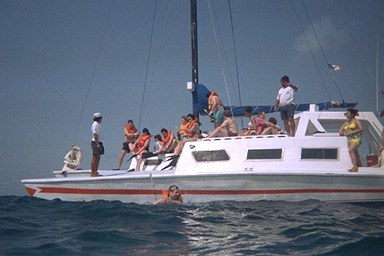 The trimaran, complete with tour guides, drinks,
and tourists -- some of whom want to go snorkeling. I, being an experienced
snorkeler, jumped in early to get this photo. (Unretouched.)
The trimaran, complete with tour guides, drinks,
and tourists -- some of whom want to go snorkeling. I, being an experienced
snorkeler, jumped in early to get this photo. (Unretouched.)On Tuesday, we took a trimaran cruise to Isla Mujeres, a small island a few miles east of Cancún. It's named because of all the female Mayan figurines discovered on the island. It's a tiny island, full of shops and restaurants, waiting for tourists.
I forgot the names of the crew aboard the trimaran, but they were a fun group of guys -- one captain, a tour guide/entertainer, and a few other guys who went around asking the tourists for their drink orders (water, sodas, and tequila sunrises). The water varied from a deep green to a lighter emerald color. It wasn't seasick-rough, but it was moderately rough. We didn't use the sails but instead travelled under power, and the trip from Cancún to the island took about an hour or so.
 The trimaran, complete with tour guides, drinks,
and tourists -- some of whom want to go snorkeling. I, being an experienced
snorkeler, jumped in early to get this photo. (Unretouched.)
The trimaran, complete with tour guides, drinks,
and tourists -- some of whom want to go snorkeling. I, being an experienced
snorkeler, jumped in early to get this photo. (Unretouched.)
Upon arrival at the island shore, a bunch of us donned snorkeling gear (mine and some others personally owned, the rest rented) and jumped in. Because the waves were choppy, the tour guides insisted we wear life preservers which, I discovered, were a very good idea. The trimaran left to wait for us at another point down the shoreline.
 Our guide, feeding the fish, plus a fellow tourist,
about ready to elbow me in the mask.
Our guide, feeding the fish, plus a fellow tourist,
about ready to elbow me in the mask.
 A barracuda.
A barracuda.
Again, there's not much point in describing the whole thing, but it was pretty fun. One of the guides came along with a bag of cracker crumbs, to attract loads of tropical fish. We saw a barracuda and lots of other colorful fish. Tourists were jostling each other to take pictures, and if you weren't careful, you kicked someone or got kicked yourself. The water was choppy and the currents were pretty strong.
I discovered that Hsuan can't swim worth a damn, even with fins, because she uses a completely useless dog-paddle kick. I had to drag her away from some sharp rocks against which she and another woman were in danger of being washed.
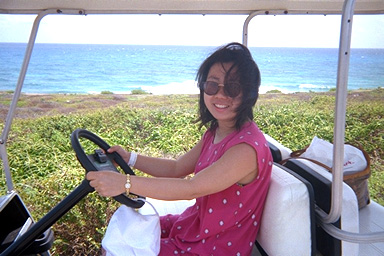 Hsuan in the driver's seat.
Hsuan in the driver's seat.
Once on the island, we had some free time before lunch, and we had the option of going shopping or renting either a scooter or a golf cart and driving around the island. I wanted to try a scooter, which would be faster, but then I was afraid that Hsuan would panic and kill us both, so we got a golf cart. We drove around the entire island and got back in time to leave with our tour group for lunch.
 The dolphin pen.
The dolphin pen.
We took the boat to a restaurant elsewhere on the island, for another buffet lunch included as part of the tour. In addition to the food and some souvenir shops, there was a dophin pen which held four or five dolphins. For a rather hefty fee, a tourist could take a swim with the dolphins. I'm not generally in favor of holding dolphins in captivity -- unless maybe they're extremely well cared for, as in some facilities in the US. Fees collected for the dolphin swim at this restaurant were to be used to care for the dolphins. I'm an astrophysicist, so what do I know about caring for cetaceans?
On the way back to Cancún, the water was a bit rougher. Hsuan and I and some other tourists sat at the very front of the boat and got soaked whenever the waves broke over the stern. Tips were collected as we arrived back at Cancún.
We rested at the hotel on Wednesday, and on Thursday, we took another day trip to the Mayan ruins at Cobá. Gerardo was our guide again, but we had another woman serving drinks and another bus driver. Our tourist material says that the city was discovered only 30 years ago (from today?), but a Fodor's Up Close Mexico guide book says it was discovered last century. Again, I'm no expert, this stuff isn't a hobby of mine, and what information I've dug up while preparing this page is either incomplete or contradictory. According to my Fodor's guide, the city originated in 400 BC, was fully developed by 500 AD, and was abandoned mysteriously 600 years before the Spanish arrived. There are some carved tablets and other writings found in Cobá which are supposed to contain prophecies of now past (previously future) and (currently) future events in Mayan civilization, including a big change (extinction?) allegedly to occur in the next decade.
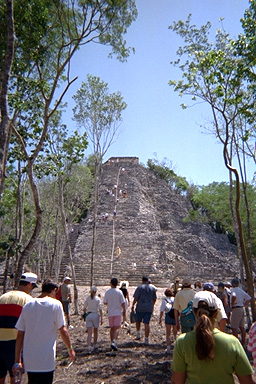 The pyramid.
The pyramid.
The tour was about what you might expect of a Mayan city -- pyramids, temples, observatories, houses, ball court, etc. I'm not saying it was dull or commonplace -- it was quite fun. Because the ruins are more recently discovered than Chichén Itzá, the reconstruction is not very complete, and the jungle still crowds the buildings. You can see how incomplete the pyramid is in the picture above. Being at Cobá has a very strong Indiana Jones appeal.
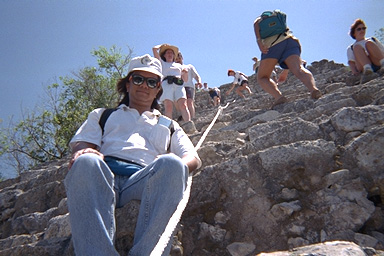 Me, sitting for a picture halfway up the pyramid. There's a rope
to help in the climb. Yes, I wore jeans, because I thought the jungle would
be rougher, but I also carried extra shirts , water, and a battery-powered
fan to help me deal with the humidity and my sweat. I always come prepared.
Me, sitting for a picture halfway up the pyramid. There's a rope
to help in the climb. Yes, I wore jeans, because I thought the jungle would
be rougher, but I also carried extra shirts , water, and a battery-powered
fan to help me deal with the humidity and my sweat. I always come prepared.
 Hsuan, at the top of the pyramid. "I thought the jungle would
be more comfortable!" (Unretouched.)
Hsuan, at the top of the pyramid. "I thought the jungle would
be more comfortable!" (Unretouched.)
Throughout the trip to, at, and from Cobá, Hsuan was a basket case. I was afraid she would experience sun stroke, so I kept a close eye on her and watched her water intake. At the very least, I was afraid she'd vomit on the bus.
 A temple... or a house... or something. (Unretouched.)
A temple... or a house... or something. (Unretouched.)
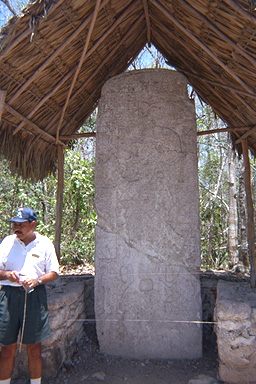 The tablet that contains the Mayan prophecy of a cataclysm in the
next decade. That's Jerry, our tour guide. (Unretouched.)
The tablet that contains the Mayan prophecy of a cataclysm in the
next decade. That's Jerry, our tour guide. (Unretouched.)
 Another ball court, this time at Cobá. Our tour group is resting
after the jungle trek.
Another ball court, this time at Cobá. Our tour group is resting
after the jungle trek.
After the tour of the ruins, we had lunch at a nearby restaurant, included in the tour package and, this time, not a buffet but with the waiters telling us the menu.
Then, after lunch, we took a tour of the limestone caverns at Aktunchen. We had a different pair tour guides at the caverns, and these guys spoke like actual geologists about the assorted rock formations and underwater pools. I assume they were real geologists working for some government tourism development agency.
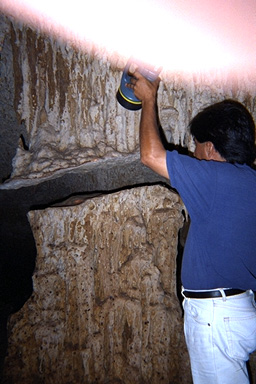 A broken column in the Aktunchen caverns.
A broken column in the Aktunchen caverns.
The caves were fun to walk through, and the explanations of the formations were clear and interesting. In the picture above, the large column is formed by a stalactite from the roof meeting a stalagmite growing from the floor. The very interesting thing about it being broken and, in this case, shifted is that the Yucatan peninsula is not seismically active. So, how did the column break? And why did the top part move to one side, relative to the bottom part?
The caves were cool but astonishingly humid. My glasses fogged up repeatedly, and while I have pictures of me and Hsuan, we both look like such goons -- in our hard hats and with our skin shining with moisture -- that I'll not embarrass either of us with pictures.
These pages were made with Macintosh (Power Macintosh 7200/75, running MacOS 8.1), Adobe PhotoDeluxe 1.1, Adobe PageMill 2.0, and Netscape Navigator 4.06 (for proofing). All photos were taken using Kodak one-use cameras, and the pictures were developed to PhotoCD. Except where noted, all photos were only "instant-fixed" via PhotoDeluxe.